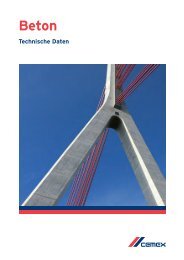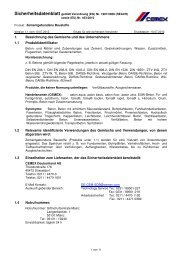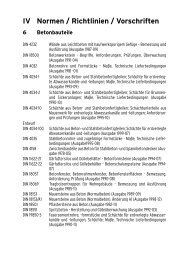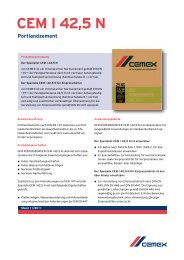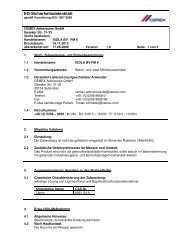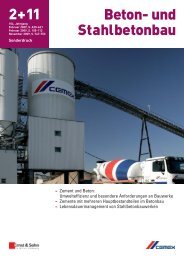building a better future - Cemex
building a better future - Cemex
building a better future - Cemex
Create successful ePaper yourself
Turn your PDF publications into a flip-book with our unique Google optimized e-Paper software.
our approach<br />
We are collaborating internally across our company to develop<br />
innovative products and solutions that address some<br />
of our customers’ most salient environmental issues. We are<br />
working to understand the environmental impact of our concrete<br />
products and to promote their sustainability attributes<br />
over their life cycle. Our industry’s collaborative research<br />
with the Massachusetts Institute of Technology (MIT) and<br />
our annual CEMEX Building Awards advance these efforts.<br />
In addition, we are developing tools that enable us to<br />
transparently communicate to our clients the environmental<br />
impact of our products. We initiated this effort by launching<br />
our CO2 Footprint Tool in 2010.<br />
In 2011, CEMEX began positioning itself as a consultant to<br />
its customers in the construction of sustainable <strong>building</strong>s. In<br />
doing so, we are moving beyond supplying <strong>building</strong> materials<br />
to providing advisory services, solutions, and technologies<br />
that help customers develop their own capabilities in<br />
sustainable construction. We will continue to develop our<br />
skills and expertise in this area.<br />
Strategic and selective external collaborations are key to<br />
CEMEX success. Our ongoing participation in the WBCSD’s<br />
Urban Infrastructure Initiative (UII), for example, has allowed<br />
us to become more deeply involved in city planning and<br />
infrastructure projects. As a result, we are gaining a deeper<br />
understanding of how our products and solutions contribute<br />
to solving the challenges of growing urbanization and<br />
increased urban density.<br />
<strong>building</strong> blocks of the <strong>future</strong>:<br />
the advantages of concrete<br />
As a <strong>building</strong> material, concrete has a number of fundamental<br />
attributes—its durability, thermal mass, versatility, and costeffectiveness—that,<br />
together, underscore its importance in<br />
sustainable construction and development. Among its other<br />
advantages, concrete contains no VOCs 1 , may be recycled for<br />
use as aggregate material, and can often be locally sourced. To<br />
<strong>better</strong> understand and fully utilize these traits, CEMEX stays<br />
closely abreast of current research such as that conducted at<br />
(continues on next page)<br />
1 Volatile organic compounds<br />
applying MIT research findings<br />
across our business<br />
Through its work with clients, collaboration with organizations<br />
such as the UII, and research and development efforts,<br />
CEMEX is working to promote the sustainability attributes<br />
of concrete, confirmed by MIT’s 2011 Concrete Sustainability<br />
Hub (CSH) research.<br />
Concrete in commercial and residential <strong>building</strong>s<br />
Concrete <strong>building</strong> materials offer significantly greater efficiency<br />
than light-frame wood construction—particularly<br />
in terms of heating and cooling. The research indicates that<br />
homes built with insulated concrete forms can see life-cycle<br />
energy savings of 5–8 percent compared with their woodframe<br />
counterparts. These benefits derive from concrete’s<br />
higher thermal mass, which reduces the effects of outdoor<br />
temperature fluctuations on <strong>building</strong> interiors—thus reducing<br />
the energy requirements of HVAC units and other electrical<br />
components.<br />
In addition, the CSH research confirms that 88 to 98 percent<br />
of CO2 emissions associated with concrete construction are<br />
produced in the usage phase of <strong>building</strong>s—meaning during<br />
a <strong>building</strong>’s usable life—and that only a small percentage of<br />
life-cycle emissions come from the concrete manufacturing<br />
process.<br />
Concrete roadways<br />
Among the preliminary CSH findings with respect to concrete<br />
highways are that the majority of emissions from<br />
highways come from their use rather their construction. The<br />
research indicates that the smoother, stiffer characteristics<br />
of concrete roadways (compared with those constructed of<br />
asphalt) may result in improved vehicle fuel efficiencies and<br />
lower GHG emissions. It is also widely understood that the<br />
Based on historical data, MIT calculates that<br />
over a 50-year time frame, the mean “real price”<br />
of asphalt can be expected to increase by 95<br />
percent while the mean “real price” of concrete<br />
would decrease by 20 percent.<br />
higher albedo (light reflectivity) of concrete pavement helps<br />
keep road surfaces cooler and therefore reduces warming<br />
at both local (urban heat island effect) and global (climate<br />
change) scales.<br />
The research identified options for reducing emissions<br />
through <strong>building</strong> and maintaining concrete roadways, and<br />
stressed the importance of good roadway design.<br />
Life-cycle cost of concrete<br />
While concrete <strong>building</strong> materials may require higher upfront<br />
investments than steel, wood, or asphalt, MIT’s research<br />
indicates that, due to concrete’s superior durability and thermal<br />
efficiency, the full life-cycle costs of operating concrete<br />
<strong>building</strong>s and roadways are actually lower than with the<br />
alternatives. Findings also note that the relative price stability<br />
of concrete offers long-term project costing benefits.<br />
Continuous improvement<br />
Although the MIT work shows that GHG emissions related<br />
to the production of concrete construction materials are<br />
dwarfed by those in the use phase, it also highlights a number<br />
of ways in which concrete producers can help reduce the<br />
life-cycle impact of <strong>building</strong>s and structures. These include<br />
innovative design features and increased use of clinker<br />
substitutes such as fly ash.<br />
Using these strategies, CEMEX can significantly reduce the<br />
life-cycle GHG emissions of its concrete <strong>building</strong> materials,<br />
while helping customers cut down on their own operating<br />
expenses, maintenance, and environmental impacts.<br />
< previous 9 next>



